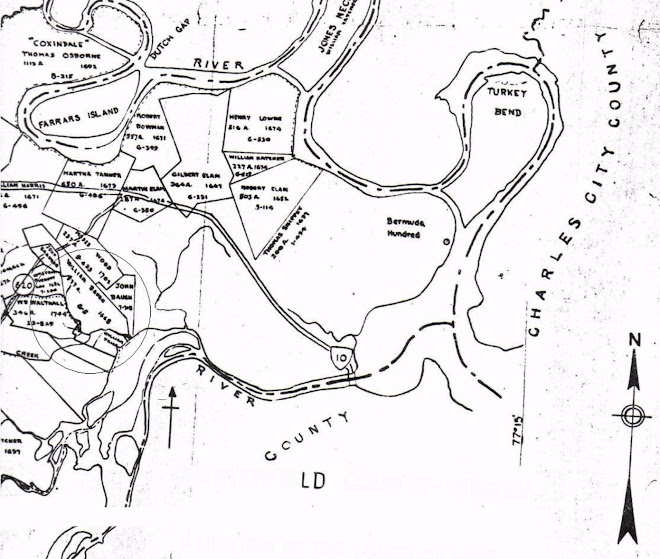(see Womack to far left)
Baugh Plantation- Ashton Creek, a branch of the Appomattox River
William Baugh Sr. arrived in Virginia from London in 1638. He was a widower and married Elizabeth Sharpe Parker about 1639 in Henrico County.
Elizabeth had arrived in Virginia on the "Francis Bonaventure" in August 1620. She married Sgt. William Sharpe (an "ancient planter in the time of Thomas Dale" and in 1624 they were living on the Bermuda Hundred with their sons Isaac and Samuel. William had 40 acres of land and was elected Burgess for Bermuda Hundred.
After his death Elizabeth married Thomas Parker, who was living with Thomas Baugh at the West and Sherley Hundred. Thomas was thought to be the son of John Baugh, and nephew of William Baugh, Sr. Thomas Baugh emigrated from Bristol, England on the "Supply" which arrived in Virginia on 29 Feb. 1621. By January 1625 he had relocated to the "College Lands." The 1624 muster recorded Thomas Parker there as well, under Thomas Osborne's command. Thomas Parker arrived in Virginia on the "Neptune" in 1618, along with William Farrar. After his marriage to Elizabeth, he died prior to July 1836.
Elizabeth was now a wealthy widow, and in July 1636 she patented 500 acres in Henrico between the Curles and Varina, part of a total of 950 acres patented in August 1637 from headrights due to transportations of 13 servants for Sharpe. This land was in Varina, east of Henricus.
Elizabeth married William Baugh Sr. in about 1639 and died before Feb 1, 1650, when her will was recorded.
William Baugh Sr.
William Baugh Sr. arrived in Virginia from London in 1638. He was a widower and married Elizabeth Sharpe Parker about 1639 in Henrico County. He lived at Kingsland and Proctor's Creek prior to 1668, when he received a land grant for 577 acres near his brother, John Baugh. He received 600 acres for transportation of 12 persons to Virginia, including his son, William Baugh, Jr. , who arrived in Jamestown about 1660. This land was on the south side of the James River, and the north side of Appomattox river near Ashton Creek. His brother, John Baugh, had a 1638 land patent near Johnson Creek.
William Baugh Jr. married Jane Hatcher Branch in 1661 but died prior to 1678 and she remarried. One of her daughters, Priscilla Baugh, married William Farrar III, and William Baugh Sr. left her a tract of land.
William Baugh Sr. married a third time after the death of Elizabeth, to Elizabeth Womack. Their children were Katherine Baugh born 1653 who married a Jones and James Baugh I born 1655 who married Elizabeth Ashbrook and Mary Baugh. Mary Baugh married 1- Thomas Howlett and 2- Thomas Byrd, the brother of William Byrd I of Westover. Thomas Byrd died in March 1710 and Mary died on May 16, 1710 and her son Thomas Howlett Jr. administered her estate with Capt. Thomas Jefferson giving security.
William Baugh Sr. was buried at the Baugh family cemetery near Ashton Creek.
Read further
http://arslanmb.org/baugh/baugh.html
https://www.jstor.org/stable/1914683?seq=1
https://www.jstor.org/stable/1914991?seq=1
http://files.usgwarchives.net/va/henrico/bios/earlyfam2.txt
Source:
https://www.findagrave.com/memorial/119190420/william-baugh by Gresham Farrar
1) "Virginia Immigrants and Adventurers, 1607-1635" by Martha W. McCartney, 2007, pp. 120, 528, 529, 631 ,632.
2) "The Farrar's Island Family" by Alvahn Holmes, 1972, p. 145.
3) "Virginia Magazine of History & Biography" Vol. 13, p58.
4) "Virginia Gleanings in England Abstracts of 17th and 18th Century English Wills and Administrations Relating to Virginia and Virginians" by Lothrop Withington, 2007, p113.
5) "Adventurers of Purse and Person, Virginia, 1607-1624/5" by John Frederick Dorman, 4th Ed., Vol. I, 2004, pp8,12,367,930.
6) "Adventurers of Purse and Person, Virginia, 1607-1624/5" by John Frederick Dorman, 4th Ed., Vol. 3, 2007, p153.
7) "Cavaliers and Pioneers. Abstracts of Virginia Land Patents and Grants" Vol. I by Nell Marion Nugent, 1983, p549.
8) "Virginia Vital Records" Indexed by Judith McGhan, 1984, p9.
"The Correspondence of the Three Byrds of Westover

